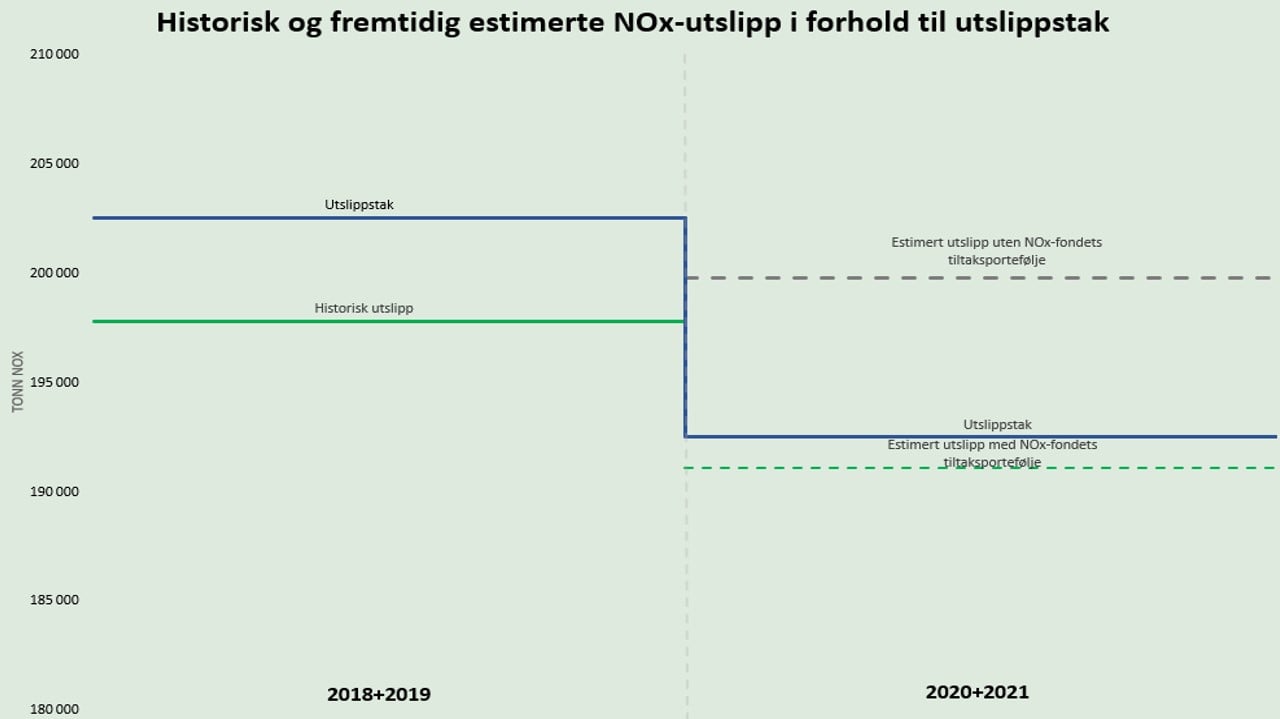NOx emission and emission ceiling
The NOx Agreement 2018-2025 assumes that the business organisations must ensure that the total emissions of NOx over periods of two years does not exceed an emission ceiling.
The NOx Agreement 2018-2025 assumes that the business organisations must ensure that the total emissions of NOx over periods of two years does not exceed an emission ceiling.
The figure below illustrates historical and estimated emissions related to the emission ceiling from the NOx Agreement 2018-2025.
Total permitted emissions in 2018 and 2019 (in the NOx Agreement 2018-2025) is 202 500 tonnes of NOx. Reported emissions to the NOx Fund were 197 800 tonnes. Divided between the two years, 100 900 tonnes were released in 2018 and 96 900 tonnes in 2019. Emissions in 2019 were approx. 4 000 tonnes lower than in 2018. This reduction fits well with the completed emission reduction measures in the NOx Fund portfolio the last 2 years.
Of the reported emissions in 2018 and 2019, 44% derives from petroleum activities on the shelf, 33% from shipping, 15.5% from the agricultural industry, 5.5% from fishing and 2% from other industries.

The level of emission in 2019 provides the business sectors with a good starting point for managing the emission ceiling for 2020 and 2021 (emission ceiling: 192 500 tonnes NOx for the two-year period, 96 250 ton annual average). With further reductions of approx. 1 000 tonnes by 2020, emissions ceiling for the next two-year period should be achievable. The NOx Fund have enough supported measures in its portfolio, but it requires that the measures are implemented, with the emission-reducing effect they are estimated to have within the stated completion time. New measures with further reductions may be needed.
In the longer term (2022-2025), further NOx-reducing measures are still needed to meet the emission ceiling. The emission ceiling is reduced by an average of 2 500 tonnes per year.
The two-year targets for 2022 and 2023 and for 2024 and 2025 are nonetheless considered to be achievable as the NOx Fund continuously works with the affiliated companies and business interest organisations. Funding are still available for new low emission measures.
The main challenge for the NOx Agreement is currently increased emissions as a result of rapid industrial expansions, which is not considered in the NOx Fund's emission predictions.
It is primarily industries with large NOx-intensive emission units which can produce such effects. Cruise ships and offshore rigs without significant NOx measures are examples. The NOx Fund is working to ensure a robust portfolio of concrete emission reduction measures that makes it possible to absorb these challenges within the emission ceilings.
Please note that figures and assessments above are subject to changes in historically reported emissions from the companies, and deviations from reported figures to the authorities. Such changes occur but are rarely of critical magnitude.
This information is updated after each quarterly reporting of NOx emissions to the NOx Fund.